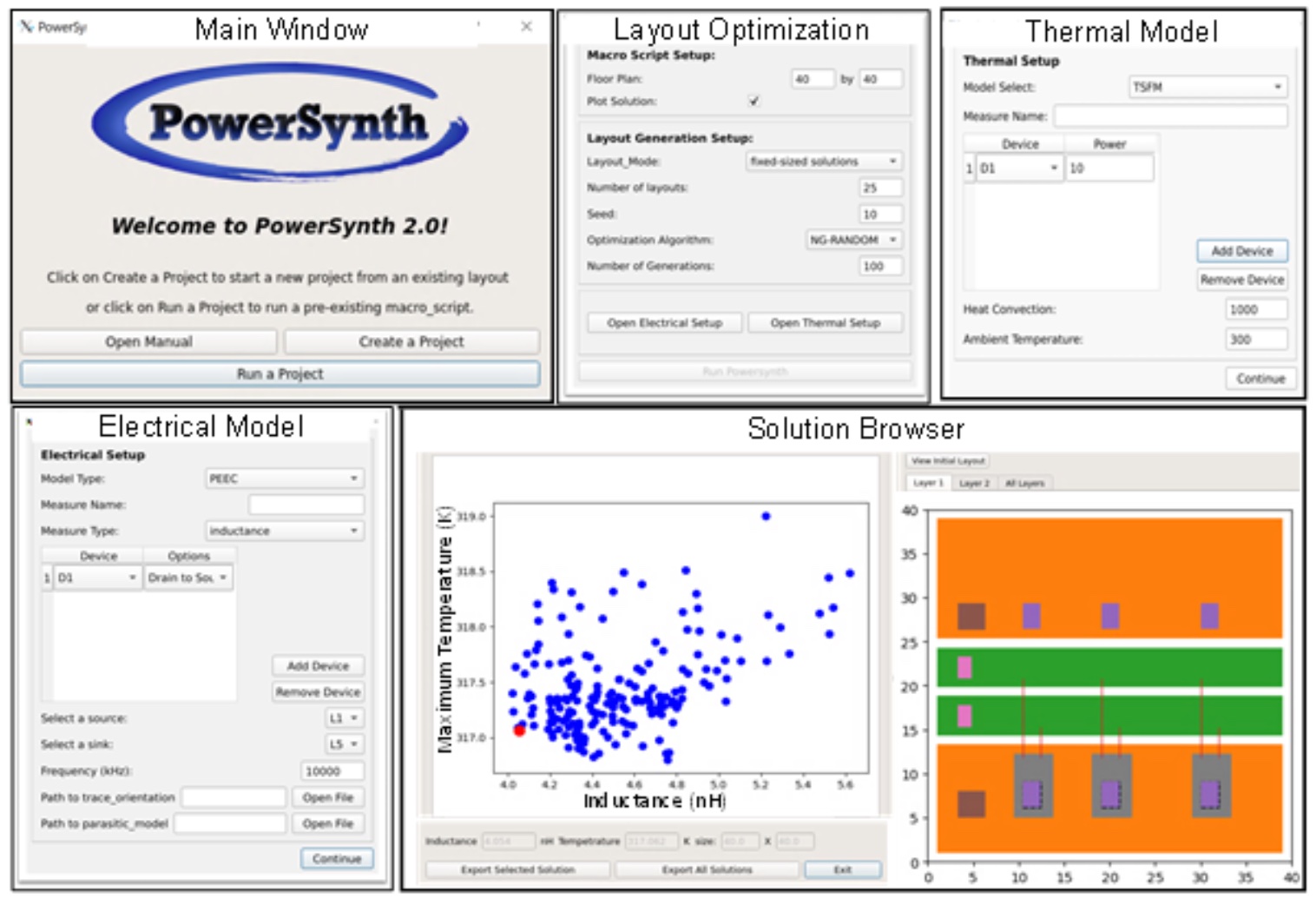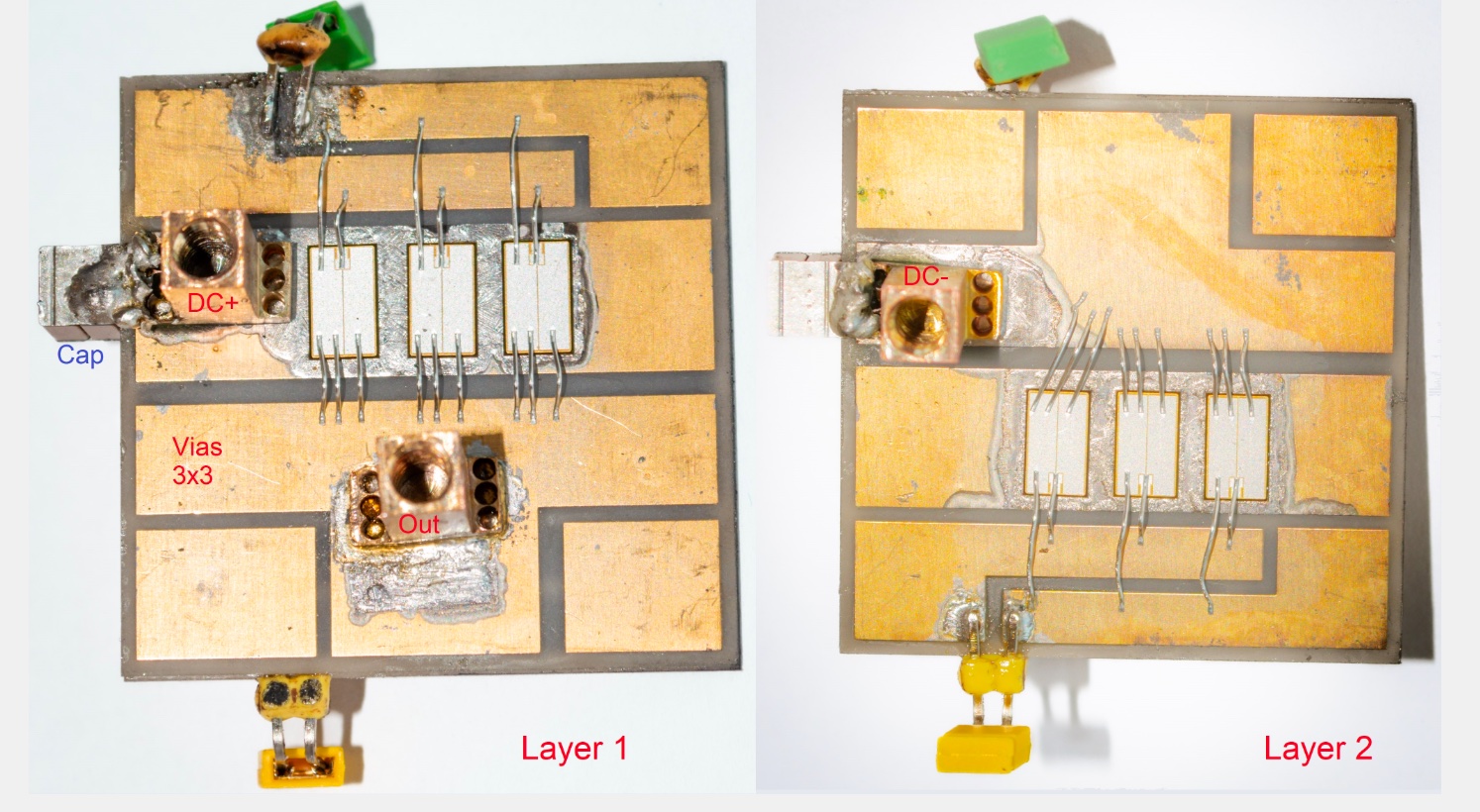Demonstration of Enhanced PowerSynth-Integrated Physical Design Flow
Outcome/Accomplishment
PowerSynth 2 — an automated software tool that improves the scalability, accuracy, and efficiency of design flows for high density multi-chip-power-modules (MCPM) — was released by researchers at the U.S. National Science Foundation (NSF)-funded Center for Power Optimization of Electro-Thermal Systems (NSF POETS) and the tool was used to demonstrate an integrated physical design flow. PowerSynth 2 is capable of handling high-density 3D layouts and incorporates both command line (CLI) and graphical user interfaces (GUI). The NSF Engineering Research Center (ERC) is based at the University of Illinois at Urbana-Champaign (UIUC) and the University of Arkansas (UA).
Impact/Benefits
The design of MCPMs requires extensive knowledge of the device, circuit, package, system, and manufacturing. Using power computer-aided design (CAD) physical design automation for power electronics and systems, designers can better understand the electrical and thermal properties of materials, multi-physics design procedures, system control, and optimization methodology to improve manufacturability and reliability.
Prior to the release of NSF POETS’ PowerSynth tool, the layout design of MCPM was performed manually with limited optimization capabilities. As a result, it took significant time to complete and required separate checks for thermal profiles whereby entire redesigns were sometimes required. Automation enabled by PowerSynth improves the layout synthesis capabilities by introducing new algorithms and novel optimization methods for MCPM parasitic extraction, thermal modeling, heterogeneous integration, and reliability enhancement. When compared with traditional flow and finite element method (FEM) tools, PowerSynth 2 achieved a 1000x speed-up and 100x memory reduction at 10-15% accuracy loss.
Explanation/Background
Package releases for both PowerSynth version 2.0 and version 1.4 are available on the PowerSynth website; the source code was released on Github. PowerSynth version 1.4 won First Place in the ECCE 2021 Student Demonstration Software Competition.
The research team was led by NSF POETS faculty members in the UA e3DA Lab, Alan Mantooth and Yarui Peng, with graduate students Quang Le, Tristan Evans, Shilpi Mukherjee, and Imam Al Razi. Both the 2D/2.5D and 3D flows have been hardware-validated. The team’s latest electrical model has achieved a 7.1% extraction error compared to Ansys Q3D while showing a 35x speed-up. PowerSynth’s electromigration (EM)-aware reliability analysis and optimization was also integrated with an electro-thermal co-design flow.
Two conference papers resulted from the work and two journal papers have been accepted. This project included collaborations among faculties and students from UA, UIUC, Stanford University, and Howard University, as well as industry liaisons from Toyota, Wolfspeed, Deere, Caterpillar, and others.
Location
Urbana-Champaign, Illinoiswebsite
Start Year
Microelectronics and IT
Microelectronics, Sensing, and IT
Lead Institution
Core Partners
Fact Sheet
Outcome/Accomplishment
PowerSynth 2 — an automated software tool that improves the scalability, accuracy, and efficiency of design flows for high density multi-chip-power-modules (MCPM) — was released by researchers at the U.S. National Science Foundation (NSF)-funded Center for Power Optimization of Electro-Thermal Systems (NSF POETS) and the tool was used to demonstrate an integrated physical design flow. PowerSynth 2 is capable of handling high-density 3D layouts and incorporates both command line (CLI) and graphical user interfaces (GUI). The NSF Engineering Research Center (ERC) is based at the University of Illinois at Urbana-Champaign (UIUC) and the University of Arkansas (UA).
Location
Urbana-Champaign, Illinoiswebsite
Start Year
Microelectronics and IT
Microelectronics, Sensing, and IT
Lead Institution
Core Partners
Fact Sheet
Impact/benefits
The design of MCPMs requires extensive knowledge of the device, circuit, package, system, and manufacturing. Using power computer-aided design (CAD) physical design automation for power electronics and systems, designers can better understand the electrical and thermal properties of materials, multi-physics design procedures, system control, and optimization methodology to improve manufacturability and reliability.
Prior to the release of NSF POETS’ PowerSynth tool, the layout design of MCPM was performed manually with limited optimization capabilities. As a result, it took significant time to complete and required separate checks for thermal profiles whereby entire redesigns were sometimes required. Automation enabled by PowerSynth improves the layout synthesis capabilities by introducing new algorithms and novel optimization methods for MCPM parasitic extraction, thermal modeling, heterogeneous integration, and reliability enhancement. When compared with traditional flow and finite element method (FEM) tools, PowerSynth 2 achieved a 1000x speed-up and 100x memory reduction at 10-15% accuracy loss.
Explanation/Background
Package releases for both PowerSynth version 2.0 and version 1.4 are available on the PowerSynth website; the source code was released on Github. PowerSynth version 1.4 won First Place in the ECCE 2021 Student Demonstration Software Competition.
The research team was led by NSF POETS faculty members in the UA e3DA Lab, Alan Mantooth and Yarui Peng, with graduate students Quang Le, Tristan Evans, Shilpi Mukherjee, and Imam Al Razi. Both the 2D/2.5D and 3D flows have been hardware-validated. The team’s latest electrical model has achieved a 7.1% extraction error compared to Ansys Q3D while showing a 35x speed-up. PowerSynth’s electromigration (EM)-aware reliability analysis and optimization was also integrated with an electro-thermal co-design flow.
Two conference papers resulted from the work and two journal papers have been accepted. This project included collaborations among faculties and students from UA, UIUC, Stanford University, and Howard University, as well as industry liaisons from Toyota, Wolfspeed, Deere, Caterpillar, and others.


